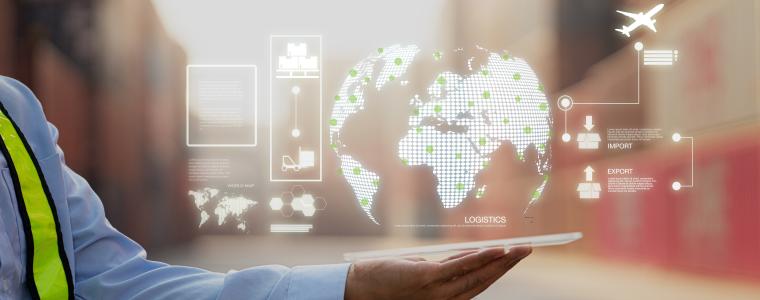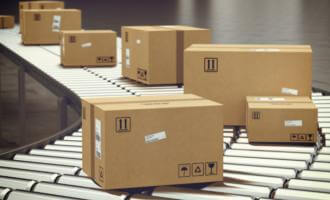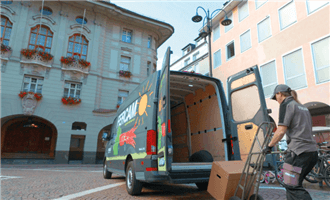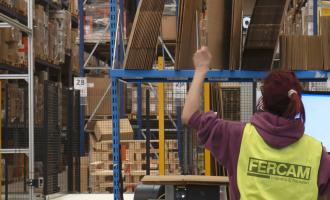
11 November 2020 - by: Eleonora Castagna
What are the advantages of using a single logistics provider?
The outsourcing of logistics and transport activities is often a necessity and is the right choice to have a guarantee of superior quality services. There are further advantages in choosing a single supplier for the different services you need, as shown by the long-standing collaboration between the Fine Art and Air & Ocean departments in FERCAM.

For many companies, the most valid strategic choice to optimize the costs and times of handling their goods is to entrust these tasks to a third party, a specialist in the field. This allows them to take advantage of know-how, investment opportunities, quality of service, and efficiency at a level that would not be achievable by managing their own logistical needs independently.
By outsourcing their own logistic operations, often companies have to deal with several operators, for example one that manages stock in the warehouse, another that takes care of local transport or specific product sectors and another that has the ability to take charge of international and overseas deliveries. But what advantages would be gained by having a single partner that takes care of every aspect of logistics and transport?
Using a single comprehensive logistics operator, it is possible to find complete and integrated solutions, even when you need to use different expertise. A cross-sector internal collaboration between the various departments of the same supplier allows the optimization of time, simplifies communication, and makes all process steps transparent. Since there are no different interests in the field, in case of unforeseen events or problems the only objective will be to overcome the difficulty as soon as possible, instead of devoting energy to assigning responsibility.
Thanks to its internal structure in 5 specialized divisions, FERCAM offers a complete logistics service, i.e. it has the possibility to take charge of every phase of the supply chain. From logistics planning to transport services, in any of its variants and according to specific needs, FERCAM will be able to respond fully to the needs of its customers.
A concrete demonstration of the operational advantage of being able to turn to specialists within the same company is offered by the cooperation between the Fine Art and Air & Ocean departments. For art logistics that specifically includes routes by air, Fine Art makes use of the solutions provided by the internal Air & Ocean division, thus being able to guarantee customers an uninterrupted high-quality service and continuous monitoring of operations.
In order to highlight some of the dynamic features of this integrated service, we asked some questions to Chiara Prisco, Business Unit manager for FERCAM Fine Art, and Elena Del Ferro, Air & Ocean manager at the FERCAM branch in Rome.
Regarding the primary advantages of this type of internal collaboration, what can we highlight?
Chiara Prisco: For our Business Unit, one of the most positive aspects of working with our in-house Air & Ocean department is the ability to track all processes in detail. In fact, we are able to follow all the handling and transport phases of the artwork in real time, so we can give clear and rapid communication to the customer.
Elena Del Ferro: It is also very important to be able to work well on unexpected events, which in our sector is a variable that absolutely cannot be ignored. Working for the same company there is extreme transparency in the management of discrepancies with respect to what has been predicted and this greatly facilitates a timely resolution. I remember that during the preparation of a large exhibition, in relation to a very valuable work of art, there was a technical inconsistency at the level of national systems. Under pressure and with little time available, we managed to solve the problem in a very efficient way. On that occasion it was very nice to see, in addition to the proactivity of both departments, a very clear and fast communication between all the operators involved.
Have you implemented changes to optimize collaboration?
Chiara Prisco: The Air & Ocean team can undoubtedly boast great expertise, but in the beginning we had to modify some of the "normal" processes to meet the specific needs of the art sector. We worked together to build a common language that would allow us to understand each other's needs and communicate quickly. To date we have firmly consolidated the relationship and the collaboration is very fluid.
Elena Del Ferro: For example now an authorization request for an underboard escort is part of our normal procedure, i.e. an escort for the artwork who goes on board together with it on the same passenger flight and goes to check when it is being palleted. Initially this process was surely a novelty, but it was soon integrated perfectly. Thanks to the collaboration with Fine Art we have acquired new competences, it has been without doubt an enrichment.
Chiara Prisco: Based on this preparation and internal alignment work, projects are designed with all the respective requirements in mind from the outset. Working times are therefore optimized, including alternative plans for the management of all variables in the first organizational phases.
What particularly impressed you in the interactions between the two departments?
Elena Del Ferro: I've always been struck by the high level of adrenaline that working in the art sector involves, the strong emotions you feel. We have great respect for all the goods we transport, but when it comes to artwork, we are talking about a value that goes beyond money, it has to do with our common cultural capital. And when a work of art that is part of the international artistic heritage is in flight, we stay alert until the transport is completed, 24 hours a day. So, we find ourselves together in the middle of the night exchanging messages and waiting for confirmations, so as not to stop closely monitoring the movement.
Chiara Prisco: The care that both departments, in a perfect harmony of intent and interest, devote to transport operations. I have observed with great pride a constant commitment, the awareness of having to maintain a very high level of attention, since we deal with very delicate operations and we have to manage complex documentation. And I add that it was beautiful when for the first time I was able to read on the transport crate the name of a colleague as a Notifier, rather than that of a stranger. In the company where I worked in previously, I could not have had a similar opportunity, because we always had to outsource suppliers. This has provoked in me a great sense of belonging, in addition to the tranquility in knowing that I can have absolute confidence.
Elena Del Ferro: Regarding this anecdote, I remember that a colleague who worked on that transport went to the airport and sent me a photo of these boxes... I couldn't believe it; it was a great honor...!
Have you received feedback from customers about these types of services managed together?
Chiara Prisco: A few days ago, I was on the phone with a customer that we recently acquired. He made me smile, because he told me that he was not only happy but very surprised that we could share the location of the artwork we were transporting in real time. It is the traceability I was referring to initially, the information that is immediately available to us thanks to the fact that we are part of the same organization. For us it is a daily practice, but it was a confirmation and a satisfaction to hear how much this was appreciated.
The choice of a multi-specialized logistics operator offering integrated solutions
By outsourcing their own logistic operations, often companies have to deal with several operators, for example one that manages stock in the warehouse, another that takes care of local transport or specific product sectors and another that has the ability to take charge of international and overseas deliveries. But what advantages would be gained by having a single partner that takes care of every aspect of logistics and transport?
Using a single comprehensive logistics operator, it is possible to find complete and integrated solutions, even when you need to use different expertise. A cross-sector internal collaboration between the various departments of the same supplier allows the optimization of time, simplifies communication, and makes all process steps transparent. Since there are no different interests in the field, in case of unforeseen events or problems the only objective will be to overcome the difficulty as soon as possible, instead of devoting energy to assigning responsibility.
FERCAM: an example of cross-sectoral collaboration between the Fine Art and Air & Ocean departments
Thanks to its internal structure in 5 specialized divisions, FERCAM offers a complete logistics service, i.e. it has the possibility to take charge of every phase of the supply chain. From logistics planning to transport services, in any of its variants and according to specific needs, FERCAM will be able to respond fully to the needs of its customers.
A concrete demonstration of the operational advantage of being able to turn to specialists within the same company is offered by the cooperation between the Fine Art and Air & Ocean departments. For art logistics that specifically includes routes by air, Fine Art makes use of the solutions provided by the internal Air & Ocean division, thus being able to guarantee customers an uninterrupted high-quality service and continuous monitoring of operations.
In order to highlight some of the dynamic features of this integrated service, we asked some questions to Chiara Prisco, Business Unit manager for FERCAM Fine Art, and Elena Del Ferro, Air & Ocean manager at the FERCAM branch in Rome.
Regarding the primary advantages of this type of internal collaboration, what can we highlight?
Chiara Prisco: For our Business Unit, one of the most positive aspects of working with our in-house Air & Ocean department is the ability to track all processes in detail. In fact, we are able to follow all the handling and transport phases of the artwork in real time, so we can give clear and rapid communication to the customer.
Elena Del Ferro: It is also very important to be able to work well on unexpected events, which in our sector is a variable that absolutely cannot be ignored. Working for the same company there is extreme transparency in the management of discrepancies with respect to what has been predicted and this greatly facilitates a timely resolution. I remember that during the preparation of a large exhibition, in relation to a very valuable work of art, there was a technical inconsistency at the level of national systems. Under pressure and with little time available, we managed to solve the problem in a very efficient way. On that occasion it was very nice to see, in addition to the proactivity of both departments, a very clear and fast communication between all the operators involved.
Have you implemented changes to optimize collaboration?
Chiara Prisco: The Air & Ocean team can undoubtedly boast great expertise, but in the beginning we had to modify some of the "normal" processes to meet the specific needs of the art sector. We worked together to build a common language that would allow us to understand each other's needs and communicate quickly. To date we have firmly consolidated the relationship and the collaboration is very fluid.
Elena Del Ferro: For example now an authorization request for an underboard escort is part of our normal procedure, i.e. an escort for the artwork who goes on board together with it on the same passenger flight and goes to check when it is being palleted. Initially this process was surely a novelty, but it was soon integrated perfectly. Thanks to the collaboration with Fine Art we have acquired new competences, it has been without doubt an enrichment.
Chiara Prisco: Based on this preparation and internal alignment work, projects are designed with all the respective requirements in mind from the outset. Working times are therefore optimized, including alternative plans for the management of all variables in the first organizational phases.
What particularly impressed you in the interactions between the two departments?
Elena Del Ferro: I've always been struck by the high level of adrenaline that working in the art sector involves, the strong emotions you feel. We have great respect for all the goods we transport, but when it comes to artwork, we are talking about a value that goes beyond money, it has to do with our common cultural capital. And when a work of art that is part of the international artistic heritage is in flight, we stay alert until the transport is completed, 24 hours a day. So, we find ourselves together in the middle of the night exchanging messages and waiting for confirmations, so as not to stop closely monitoring the movement.
Chiara Prisco: The care that both departments, in a perfect harmony of intent and interest, devote to transport operations. I have observed with great pride a constant commitment, the awareness of having to maintain a very high level of attention, since we deal with very delicate operations and we have to manage complex documentation. And I add that it was beautiful when for the first time I was able to read on the transport crate the name of a colleague as a Notifier, rather than that of a stranger. In the company where I worked in previously, I could not have had a similar opportunity, because we always had to outsource suppliers. This has provoked in me a great sense of belonging, in addition to the tranquility in knowing that I can have absolute confidence.
Elena Del Ferro: Regarding this anecdote, I remember that a colleague who worked on that transport went to the airport and sent me a photo of these boxes... I couldn't believe it; it was a great honor...!
Have you received feedback from customers about these types of services managed together?
Chiara Prisco: A few days ago, I was on the phone with a customer that we recently acquired. He made me smile, because he told me that he was not only happy but very surprised that we could share the location of the artwork we were transporting in real time. It is the traceability I was referring to initially, the information that is immediately available to us thanks to the fact that we are part of the same organization. For us it is a daily practice, but it was a confirmation and a satisfaction to hear how much this was appreciated.
Share


 Language
Language

























